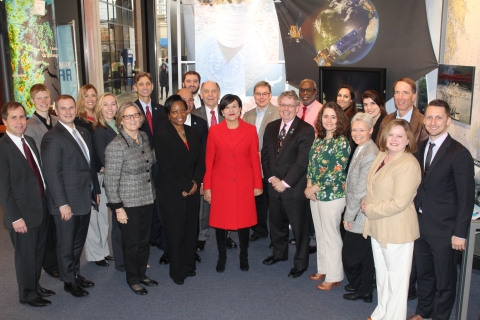Dec142016
Posted at 12:06 PM
On November 19, 2016, GOES-R, the nation’s most advanced weather satellite to-date, lifted off from Cape Canaveral, Florida at 6:42 p.m. EST.
After a thrilling countdown that used every minute of the launch window, GOES-R began its journey to space. Roughly three and a half hours after launch, GOES-R separated from its upper stage engine and the spacecraft came alive, deploying the first stage of its solar array. In the days that followed, the GOES-R team confirmed satellite communication and power and initiated several maneuvers to bring the satellite into orbit.
Nearly ten days after launch, GOES-R executed its final liquid apogee engine burn and moved into geostationary orbit approximately 22,000 miles away – officially becoming known as GOES-16.
The satellite has now deployed its final instruments and has moved into its precise checkout orbit. The team has continued to maneuver the satellite into its precise orbit, powering on and testing its instruments. Within a year, after undergoing checkout and validation of its six instruments, the new satellite will become operational.
“The next generation of weather satellites is finally here. GOES-R is one of the most sophisticated Earth-observing platforms ever devised,” said NOAA Administrator Kathryn Sullivan, Ph.D. “GOES-R’s instruments will be capable of scanning the planet five times faster and with four times more resolution than any other satellite in our fleet. With these new instruments and powerful new capabilities, GOES-R will strengthen NOAA’s ability to issue life-saving forecasts and warnings and make the United States an even stronger, more resilient Weather-Ready Nation.”
GOES-R, now known as GOES-16, will scan the skies five times faster than today’s GOES spacecraft, with four times greater image resolution and three times the spectral channels. It will provide high-resolution, rapid-refresh satellite imagery as often as every 30 seconds, allowing for a more detailed look at a storm to determine whether it is growing or decaying.
GOES-16 data will help improve hurricane tracking and intensity forecasts, the prediction and warnings of severe weather, including tornadoes and thunderstorms. Additionally, GOES-16’s improved rainfall estimates will lead to more timely and accurate flood warnings.
“We are ready to receive and process GOES-R data into our forecasts as soon as it is available,” said NOAA National Weather Service Director Louis W. Uccellini, Ph.D. “Forecasters will not only have sharper, more detailed views of evolving weather systems, they will have more data – better data – ingested into our weather models to help us predict the weather tomorrow, this weekend and next week. This is a major advancement for weather forecasting.”
For the aviation sector, GOES-16 will deliver clearer views of clouds at different atmospheric levels, generating better estimates of wind speed and direction and improved detection of fog, ice and lightning. This will improve aviation forecasts and flight route planning to avoid hazardous conditions such as turbulence.
“GOES-R will significantly improve the ability of emergency managers across America to prepare for, and respond to, weather-related disasters. Better situational awareness will result in better outcomes – from where to best position resources ahead of a storm to delivering more targeted information to local officials to decide if an evacuation is necessary,” said Craig Fugate, FEMA administrator.
GOES-16 is flying six new instruments, including the first operational lightning mapper in geostationary orbit. This new technology will enable scientists to observe lightning, an important indicator of where and when a storm is likely to intensify. Forecasters will use the mapper to hone in on storms that represent the biggest threat. Improved space weather sensors on GOES-16 will monitor the sun and relay crucial information to forecasters so they can issue space weather alerts and warnings. Data from GOES-16 will result in 34 new or improved meteorological, solar and space weather products.
“We’ve crossed an historic performance threshold with GOES-R,” said Stephen Volz, Ph.D., director of NOAA’s Satellite and Information Service. “NOAA is now operating the most sophisticated technology ever flown in space to help forecast weather on Earth.”
There are four satellites in the GOES-R series: –R, –S, –T and –U, which will extend NOAA’s geostationary coverage through 2036.
“NOAA and NASA have partnered for decades on successful environmental satellite missions," said Sandra Smalley, director of NASA’s Joint Agency Satellite Division, which worked with NOAA to manage the development and launch of GOES-16. “[This launch] continues that partnership and provides the basis for future collaboration in developing advanced weather satellites.”
Beyond weather forecasting, GOES-16 will be part of SARSAT, an international satellite-based search and rescue network. The satellite is carrying a special transponder that can detect distress signals from emergency beacons.
Over the next year, the GOES-R team will prepare the satellite for its ultimate mission: to boost the nation’s weather observation network and NOAA’s prediction capabilities, leading to more accurate and timely forecasts, watches and warnings.
For more information, see U.S. Commerce Secretary Penny Pritzker's remarks at the GOES-R launch ceremony and her op-ed on "Launching the Next Generation of Satellites."
This blog is a part of a monthly series highlighting the contributions of the Commerce Department’s agencies to the Open for Business Agenda. This month’s focus is Environment.


